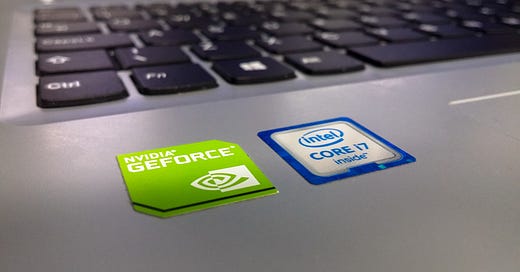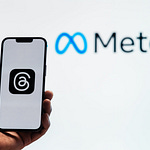In this episode, we discuss Nvidia and the AI hype, takeaways from Jackson Hole, and the poor comps for retailers.
The episode is based on yesterday's newsletter which is available on Substack.
Mission Not Accomplished
Summary: Jerome Powell spoke at the Fed’s Jackson Hole Conference last week and signaled that we still have a long way to go to get back to the Fed’s inflation target. While he views the Fed’s current policy as restrictive, inflation remains too high. Meanwhile, retailers reported results last week and gave a gloomy view of the consumer. Comps were weak…
A transcript of this podcast, with relevant images and quotes, is available for all subscribers after the show notes below. Our podcast is available on Apple Podcasts, Spotify, Google Podcasts, YouTube, and Amazon Music.
Show Notes
00:00:00 Introduction
00:00:20 Takeaways From Jackson Hole
00:03:25 Poor Comps for Many Retailers
00:05:17 A Pressured Consumer
00:06:38 Shrinkage
00:07:38 Nvidia and the AI Hype
00:10:40 Nvidia’s Moat
00:12:40 Conclusion
Transcript
Introduction
[00:00:00] Scott: Welcome everyone to a new episode of the Transcript podcast. You've got me, Scott Christoff, I'm editor of the Transcript, along with Erick Mokaya, who's our lead author.
Takeaways From Jackson Hole
We sent out a new issue of the newsletter yesterday, and we had some comments from Jackson Hole last week. We also had a big chunk of commentary from retailers who are reporting most recent results. Starting with Jackson Hole, it looked like Jerome Powell's speech was a little bit more leaning hawkish still it definitely didn't feel like a mission-accomplished type of speech. And in fact, we titled the newsletter Mission Not Accomplished. Jerome Powell saying that we still have a long way to go until we fully get inflation under control and showing commitment to that 2% inflation rate. Eric, any thoughts on this?
“My remarks this year will be a bit longer, but the message is the same: It is the Fed's job to bring inflation down to our 2% goal, and we will do so. We have tightened policy significantly over the past year. Although inflation has moved down from its peak—a welcome development—it remains too high. We are prepared to raise rates further if appropriate, and intend to hold policy at a restrictive level until we are confident that inflation is moving sustainably down toward our objective.” - Fed Chair Jerome Powell
[00:00:46] Mokaya: In his speech, he talks about them hiking, the possibility of them hiking further or pausing. There is nothing like cutting rates anytime soon. So that's clearly a hawkish trend in terms of talking. And then it seems like nothing really has changed since last year in the sense that the job is not yet done. That's a key message you take away from this, A bit of reiteration, the fact that 2% is the target. That's also a general reminder that hey, we may be at around 3% or 4%. We need to get below 2% for us to feel like it's mission accomplished. So the title of this week's newsletter is clearly mission is not yet accomplished. And then the other thing that I picked up is he's been saying that for the past couple of months is about balancing risks. I feel like the other point where they're really evaluating whether they should touch in a little bit further or wait for what they've tightened so far to see what the impact is on the economy. So that's the point at which we are. So my bet is next month, maybe a 25 basis point hike a little bit to see where we are at now. What's your feel so far from Jackson Hole?
[00:01:52] Scott: Yeah, I think the idea of a hike is still not probably what my expectation is. I think that they're probably on pause at best unless the data starts to support some sort of hike. I think the data would have to change in order to get to some sort of hiking scenario at their next meeting. But I think that markets had been expecting them to turn incrementally more dovish rather than maintaining their hawkishness. And so from that standpoint, just a maintenance of hawkishness is bearish for capital markets on the margin, I think. And so I think you may see some movement around recognition of where the Fed's stance is.
[00:02:39] Mokaya: But if you look at markets last week, it seems like they're very, Or whatever is happening at Jackson Hole it seems like it's just a continuation of the same thing. Nothing really drastic happened after Jackson Hole. Is that like they've already factored in the fact that the Fed will maintain a hawkish outlook and then they're waiting for the point where they tried to indicate that they've turned and then that's when maybe markets will actually respond.
[00:03:03] Scott: Markets had been pricing in turned towards a more dovish outlook, that less tightening and a little bit easier monetary policy. And so if the Fed comes in and reiterates that they're planning to maintain this policy that the Fed sees as restrictive, then that would be a letdown for capital markets for equity prices.
Poor Comps for Many Retailers
"At Macy's, net sales declined 9.3% and comparable sales declined 8.2% on an owned plus licensed basis." - Macy's CEO Jeffrey Gennette
"Comp store sales for the second quarter increased 4% versus our guidance of 2% to 4%. T…We are a little disappointed with these numbers…We had hoped to do better." - Burlington Stores CEO Michael O’Sullivan
[00:03:25] Mokaya: Maybe another point that we picked up of course is that consumer confidence is up, especially in the second half of the year. You can feel, especially as retailers report, they're saying consumers are starting to feel a bit more the fog is clearing up a bit. They're able to, they want to spend, but they're waiting a bit. They're under pressure, but they want to spend, but their confidence is a bit up. Let's contrast that to the first bit of the year where, Now also the most of last year where everyone was expecting a recession to hit the consumer really hard. And that's not turned out to be the case. Comps that the retailers are reporting are a bit weak but they're saying, especially as back to school season starts it's starting to be a bit better than expected. Any pickings for you from the retail section especially?
[00:04:12] Scott: Yeah I was surprised to hear you say that the commentary from retailers was more positive on consumers. I think my takeaway was that it was a pretty negative set of commentary from retailers. Mostly their comps were so negative. High single-digit negative comps for several of these retailers that we covered last week. , but then also talking about consumers being cautious. And this is something that retailers have been talking about for months as consumers being cautious. But I think the gravity of the actual performance struck me. And then the other part of it was Macy's talking about how their delinquencies rose sharply beyond their expectations, their credit card delinquencies. That was a big red flag to me. If credit quality is deteriorating, if the stimulus that had been going to consumers is really finally starting to run out and low and moderate-income consumers are starting to pull back that would be pretty bearish. That would be a change in economic prospects as well.
A Pressured Consumer
"While consumer confidence has strengthened, there are signs pointing to moderating growth going forward. Many consumers have begun to reduce overall spending, credit card debt remains high and the restart of student loan repayments is approaching." - Ulta Beauty President David Kimbell
[00:05:17] Mokaya: I should clarify that what I meant by being positive is consumer confidence, not the actual spending. The comps are pretty negative. It's just the confidence. I don't know if that is a bit of an indicator or a bit coming off from what is happening in the capital markets where consumers also see the stocks are not falling so much and it feels like they're okay. They're okay-ish. But the actual spending is as you said Macy is saying consumers are cutting back aggressively on spending. Trying to contain themselves. The low-income consumer especially is also very significantly challenged. And I think for me the most interesting beat is Dollar Stores saying that they are receiving more high-income consumers coming to shop there. That's a pretty bearish indication because usually the kind of consumers who go there's mostly low-income, I would say. Is that something you agree with in that assessment?
[00:06:08] Scott: Yeah, I think it's also an indication that $125,000 isn't as high income as it used to be. And that's driven by inflation, yeah If you have inflation, that's just the way it is that incomes rise, but the purchasing power doesn't. And so a family making $125,000 a year now has a lot less purchasing power than they used to. And may try to shop at retailers like the Dollar Store where you can maximize your value. This podcast is not sponsored by the Dollar Store.
Shrinkage
[00:06:38] Mokaya: That's true. One more thing that retailers mentioned pretty much is shrink, stealing from shops. It's pretty heightened, and I don't know if it's an excuse for the negative comps but it seems like a real issue in Walmart I think the previous week talked about It's high, especially in states where there is a bit of a minimum below which they can't prosecute you for things like that. And then Gap saying Hey, we don't see shrink. Is it because Gap is not the kind of story anyone wants to steal from or what's the take, what's your take, especially on the issue of shrink?
[00:07:14] Scott: I don't know. I think this is more like a political commentary than actual economic commentary. I haven't seen numbers that suggested to me that this impacts profits in a meaningful way or a way that would register for our purposes. But certainly, if you're trying to push a narrative of the decline in society in the United States, shrink would be an issue for sure.
Nvidia and the AI Hype
[00:07:38] Mokaya: I actually didn't pick that up to be a political issue. Beyond that, we have Nvidia reporting earnings last week and they were extremely strong. The AI revolution keeps going on with Nvidia, It blew past people's expectations of what a normal quarter should be. And the expectations were pretty high in that regard, and it seems like for the rest of the year they have pretty good visibility in terms of very high demand for AI and they seem to be ramping up together with their supply chains in terms of being able to be able to supply, to meet this very high demand. That's a key takeaway for the tech section. Nvidia is still going strong and still benefiting a lot from the AI revolution that is currently happening.
[00:08:19] Scott: Yeah do you feel like the AI hype is continuing to grow or do you think we're at like a moderating point right now?
[00:08:26] Mokaya: I feel like we are at the point where now we've heard a lot about the AI revolution happening, but I think now companies are having to have to produce actual products to match the hype. I feel like the next one or two quarters may be a bit harsh for some of the companies who have been hyping that we are actually doing something in terms of AI. And the adoption cover has not been that fast. So the companies are putting a lot of orders for chips that they expect to use, but I feel like the utilization may not be as big as they expect it to be, or at least the adoption of the products that they want to produce may not be as high as they want it to be meaning that there may be excess capacity soon in some of these companies. What's your feeling about where we are at in terms of the hype cycle?
[00:09:14] Scott: I definitely believe that AI is a long-term trend, and I think chatGPT was a huge lag for the world as to what AI is capable of doing. But I think that productization is lagging the perception of what AI is capable of doing right now. And I think it's gonna be a while before the productization actually is able to take on all of the hype. Like I see myself using chatGPT less right now than I was two months ago. I don't know how other people are feeling about it, but I don't know. I think the long-term trend is there and certainly the thing is that NVIDIA's really a Capex play from the data centers. And so as they're building more AI capabilities. The orders, to your point, the customers are there and are going to keep investing large amounts. I don't think the amount of investment that the hyperscalers or the big data center players are going to make into this is going to decline. I think that the tailwinds are real
[00:10:18] Mokaya: Over-ordering Issues. Does that concern you in the medium term at least?
[00:10:23] Scott: Over-ordering, not in the near term. I think the way that things flip on Nvidia is if there's some other competitor that comes out with a better chip that can do the same performance at lower volumes or lower energy.
Nvidia’s Moat
[00:10:40] Mokaya: And that's a hard thing to do. They have a pretty strong moat in that regard. To get to the scale at which they are at and to play at their level it will take you around 10 years to get to where they are.
And by the time you get there, they're way ahead of the curve. They've been doing this for 20 years and they have some extreme capabilities in terms of production. But I agree with you though. Nvidia has a huge tailwind behind them. And they will keep growing as much as possible. They seem to be like the only player in the market, the only game in the market, so to speak. In terms of the AI play, are there any other companies that you're tracking in terms of AI capabilities?
[00:11:14] Scott: That's it. In public markets, there's just not enough out there, and that's part of why NVIDIA's stock is going crazy, I'm sure.
[00:11:26] Mokaya: I agree with you. I've actually barely used ChatGPT in a while, and I think at the beginning as a bit of the hype thing, and then now you're back to using your Google back to Googling as you were before, and even being, you tried it a little bit and then you're back to Google at the end of the day.
[00:11:41] Scott: But if you, if you think about productization, there's a lot of companies that are probably trying to incorporate it. And you look at our own progression with it at the transcript and things that we're Loading up to do with AI. We're at an early touchpoint. It's really easy to use AI to do some of the things that we do. And so we're loading it up right now in our product stack, and hoping to be able to roll that out to people later this year. I would assume there's a lot of organizations that are going through the same investment cycle right now, so you may see more chatGPT productization out in the wild over the next six months than you have seen previously and that could boost psychology around the use of AI.
[00:12:25] Mokaya: So then prepare for more products infused with those kinds of Chat GPT-like capabilities?
[00:12:30] Scott: I think so. It'll be interesting to see what our own experiences with it on the backend and like the costs of using it and the value to our customers.
Conclusion
[00:12:40] Mokaya: I think from my observation, at least on our backend, I feel like it's very useful in terms of, especially the aggregation. It does, it's very good in terms of complimenting our skills and very good in terms of optimizing and helping us be a bit more productive from the backend. So I think our listeners will be very happy to see some of the stuff that we've been working on in a while. I think that’s a good point that we should close the podcast this week. Thank you so much for joining us and see you again soon on another edition of the Transcript Podcast.















Share this post